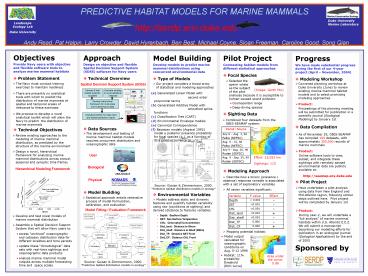Objectives - PowerPoint PPT Presentation
1 / 1
Title:
Objectives
Description:
We have made substantial progress during the first of our 4-year project (April ... access 'archived' oceanographic and cetacean distribution data for different ... – PowerPoint PPT presentation
Number of Views:35
Avg rating:3.0/5.0
Title: Objectives
1
PREDICTIVE HABITAT MODELS FOR MARINE
MAMMALS http//serdp.env.duke.edu Andy Read,
Pat Halpin, Larry Crowder, David Hyrenbach, Ben
Best, Michael Coyne, Sloan Freeman, Caroline
Good, Song Qian
Duke University Marine Laboratory
Landscape Ecology
Lab Duke University
- Objectives
- Provide Navy users with objective and flexible
software tools to analyze marine mammal habitats
- Problem Statement
- Approach
- Design an objective and flexible Spatial Decision
Support System (SDSS) software for Navy users - Technical Overview
- Data Sources
- Model Building
- Develop models to predict marine mammal
distributions using concurrent environmental data
- Type of Models
- Pilot Project
- Contrasting habitat models from different
statistical approaches - Focal Species
- Sighting Data
- Progress
- We have made substantial progress during the
first of our 4-year project (April November,
2004) - Modeling Workshop
- Data Compilation
- Selected the
sperm whale
as the subject
of the pilot
analyses because it is susceptible to
human-caused sound pollution - Cosmopolitan range
- Deep-diving species
- The Navy must conduct training exercises to
maintain readiness - There are presently no analytical tools with
which to predict the distribution of marine
mammals at spatial and temporal scales of
relevance to these exercises - We propose to develop a novel analytical toolkit
which will allow the Navy to predict the
distribution of marine mammals
- Convened planning workshop at Duke University
(June) to review existing marine mammal habitat
models and to select promising modeling
approaches - Product
- Proceedings of the planning meeting will be
submitted for publication in a scientific journal
(Ecological Modeling) by January 1st
- Our project considers a broad array of
statistical and modeling approaches
Spatial Decision Support System (SDSS)
(Image Garth Mix)
- Generalized Linear Model with
- second order polynomial terms
- (b) Generalized Additive Model with smoothed
spline functions - (c) Classification Tree (CART)
- (d) Environmental Envelope models
- (e) Canonical Correspondence
- (f) Bayesian models (Aspinal 1992)
model a posterior presence probability for focal
species (pp), as a function of its a priori
occurrence (ppp / ppa)
- Combined four datasets from the OBIS-SEAMAP
system
- The development and testing of marine mammal
habitat models requires concurrent distribution
and oceanographic data
- As of November 29, OBIS-SEAMAP has compiled 100
datasets, with approximately 300,000 records of
marine mammals - Product
- Online software tools to view, subset, and
integrate these sightings with remotely sensed
environmental data are publicly available at - http//seamap.env.duke.edu
- Review existing approaches to the modeling of
marine mammal distribution, as predicted by the
structure of the marine environment - Design a novel, hierarchical framework for
analyzing marine mammal distributions across
annual, seasonal and synoptic time frames
User
Effort 23,093 km Sightings 115
Biological
Hierarchical Modeling Framework
OBIS-SEAMAP
- Describe how a binary (presence / absence)
response variable is associated with a set of
explanatory variables - All seven variables significant
- Mapping potential habitat
Physical
Source Guisan Zimmermann, 2000. Predictive
habitat distribution models in ecology
- Have undertaken a pilot analysis using data from
New England and Mid-Atlantic region, following
similar steps outlined here. Pilot project will
be completed by January 1st - Product
- During year-2, we will undertake a full
analysis of marine mammal habitats within U.S.
Atlantic E.E.Z. We will submit a manuscript
describing our modeling efforts for publication
in an ecological journal (Ecological
Applications) by the end of 2005
- Statistical approach entails reiterative process
of model formulation, calibration, and evaluation
Model Fitting / Evaluation Framework
- Develop and test novel models of marine mammal
distribution - Assemble a Spatial Decision Support System that
will allow Navy users to - access archived oceanographic and cetacean
distribution data for different localities and
time periods - update these climatological data sets with
real-time sightings and oceanographic data
products - analyze marine mammal model outputs across
multiple forecasting time and space scales
- Model output calculated for oceanographic
conditions on Aug. 5-12 1998
- Habitat 11 probability threshold
(ROC curve)
Area under the curve 0.86
Source Guisan Zimmermann, 2000. Predictive
habitat distribution models in ecology































